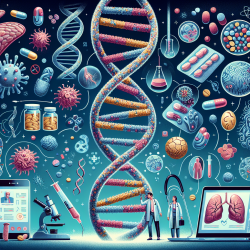In recent years, the field of epigenetics has gained significant attention due to its potential to revolutionize our understanding of human diseases. Among various epigenetic modifications, DNA methylation stands out as a key player in the pathogenesis and progression of numerous conditions. This blog post delves into the findings from the research article "DNA Methylation in Human Diseases" and offers insights for practitioners looking to enhance their skills or explore further research avenues.
The Role of DNA Methylation in Disease Pathogenesis
DNA methylation involves the addition of a methyl group to the fifth carbon position of cytosine residues within CpG dinucleotides. This modification can regulate gene expression without altering the primary DNA sequence. Aberrant DNA methylation patterns have been implicated in a wide range of human diseases, including monogenic epigenetic disorders, autoimmune diseases, metabolic disorders, hematologic malignancies, and solid tumors.
Implications for Diagnostics and Prognostics
The research highlights that aberrant DNA methylation can serve as a valuable biomarker for diagnosing and prognosticating various diseases. For instance, specific methylation patterns have been identified as diagnostic markers in autoimmune diseases like systemic lupus erythematosus (SLE) and rheumatoid arthritis (RA). In cancer research, DNA methylation profiles are being used to detect minimal residual disease (MRD) and predict patient outcomes.
Therapeutic Approaches Targeting DNA Methylation
The study also explores the potential of targeting DNA methylation machinery for therapeutic purposes. While some DNA methylation inhibitors have shown promise in treating hematologic malignancies, their application in solid tumors remains limited due to challenges such as high toxicity and non-specific action. However, advancements in CRISPR technology offer hope for more precise interventions by targeting specific genomic sites.
Practical Insights for Practitioners
- Stay Informed: Keeping abreast of the latest research on DNA methylation can provide valuable insights into emerging diagnostic and therapeutic strategies.
- Consider Biomarkers: Incorporating DNA methylation biomarkers into clinical practice could enhance diagnostic accuracy and treatment personalization.
- Explore Collaborative Research: Engaging in collaborative research efforts can help bridge gaps between basic science and clinical application.
- Leverage Technology: Utilize advanced technologies like CRISPR to explore targeted epigenetic therapies.
The study of DNA methylation is at a phenomenal intersection where each discovery can unravel new mysteries about various diseases. By understanding these mechanisms, practitioners can introduce new diagnostic and prognostic biomarkers and propose patient-tailored therapeutic approaches.
To read the original research paper, please follow this link: DNA methylation in human diseases.










